|
1.
CENTRAL AND WEST AFRICA
Demand trends – producer views
The Middle East market is showing improved timber
demand helping to reduce stocks. Nevertheless, future
prospects remain uncertain because there are no major
construction projects reported in Dubai or neighbouring
countries.
Demand in the Philippines for Okoume, Dabema and
contracts for Iroko remain robust.
The Vietnamese market also appears stable with no signs
of diminished demand.
No improvement is evident in the Chinese market. Large
inventories of unsold apartments are a concern as is the
decline in disposable income among the working
population.
It has been reported that timber stocks in In Zhangjiagang
Port are sufficient for up to two years at current levels of
sales illustrating the severity of the market slowdown.
Regional round-up
Gabon
The new forestry code with around 800 articles is under
development but local observers say adoption is unlikely
until after the presidential election in April.
Most parts of the country have had uninterrupted
electricity supply thanks to the newly installed Turkish
power ships.
Up-country transport remains slow and trucks from the
mid and southern regions can take two to three days to
reach Libreville.
Harvesting activities remain virtually the same as in the
previous update as heavy rains in up-country regions
continue to hinder operations. Ongoing roadwork along
National Highway 3 near Ndjolé has been slow resulting
in transport delays of two to three days for timber coming
from the central and southern parts of the country to
Libreville.
Rail capacity available for timber has expanded since the
decline in manganese shipments to China. It is reported
that the railway operator, SETRAG, is seeking financial
aid to repair damaged track segments and bridges. Plans
for a second rail line from the Belinga iron mining site
have come to a standstill.
Container availability at Gabonese Ports is reported as
adequate with most vessels experiencing a turn-around of
just a few days. However, exporters are concerned about
the higher port charges and an increase in export duties.
Producers in Gabon report overall market conditions
remain steady, albeit with the same challenges of sluggish
demand and tight local compliance rules.
Cameroon
Conditions are extremely dry in the Mid and South, with
Yaoundé struggling to provide adequate water supplies.
Production is gradually increasing under CFAD (the
Forestry Concession compliance framework) which could
help producers in meeting EUTR requirements.
Container stocks at Cameroon Ports are said to be
adequate. Timber exports through Douala Port have
declined partially due to CFAD enforcement along with
cooling market demand. Observers report lower
throughput of logs from the northern Congo through Kribi
Port as Congo is now in the rain season.
There are no reported changes in truck routes from forest
to mill or log depot and production appears unchanged.
While order volumes are described as “stable to low,”
Azobe logs and timber continue to find some buyers in
Holland but shipments of redwoods and Ayous have
slowed.
Demand in China for redwoods, Ovangkol and Okan is
low, mirroring the broader global market downturn.
Meanwhile, Middle Eastern interest in Iroko, Sapelli and
redwoods has improved slightly say producers. Overall,
the timber industry continues to rely on small volume
orders with mills keeping moderate log inventories of
about three months.
Although no new policy decisions have been announced
government controls are intensifying. Trucks carrying
timber arriving at Douala or Kribi must present verifiable
forestry and tax documentation.
Republic of Congo
No major forest policy developments have been reported .
Pointe-Noire Port faces up to five days of vessel backlog.
The country faces financial challenges despite steady oil
exports but reduced revenue from timber exports.
Sawmills are reported to have sufficient log stocks but
only orders for the next one to two months. This especially
applies to the redwoods.
Mill operations face no new challenges and the availability
of spare parts for logging machinery is good indicating no
immediate supply bottlenecks. Overall production is stable
though market demand is soft.
No new government policy changes have been announced
and the regulatory framework remains steady.
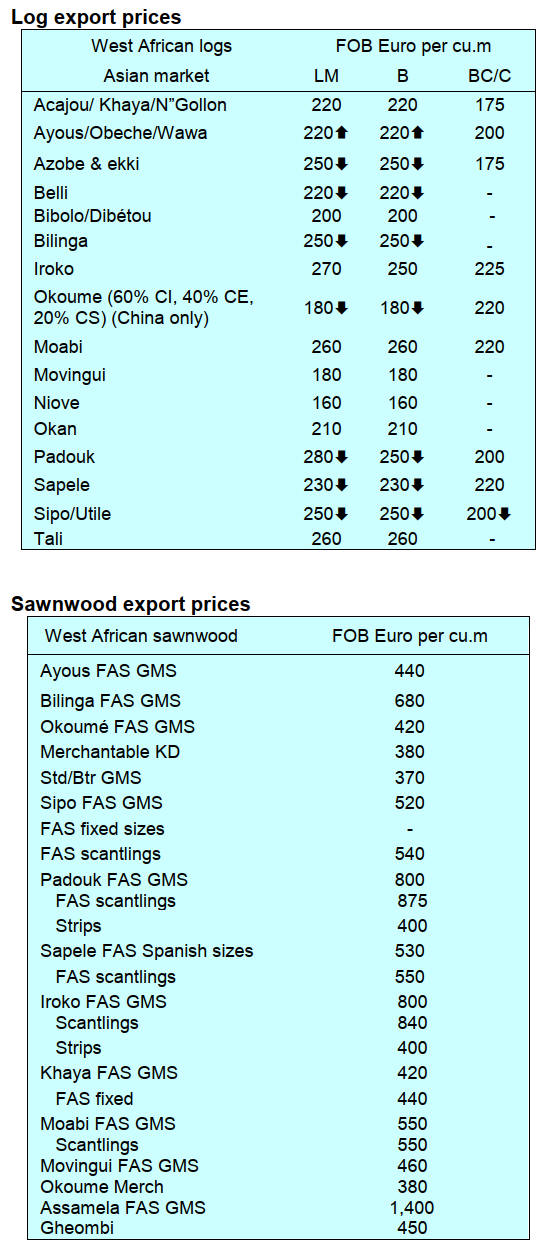
Through the eyes of industry
The latest GTI report lists the challenges identified by the
private sector in the Republic of Congo and Gabon.
See: https://www.itto-
ggsc.org/static/upload/file/20250318/1742261179154976.pdf
2.
GHANA
January wood products exports steady
According to the Timber Industry Development (TIDD)
timber and wood export report for January 2025 the
country exported twelve different wood products with a
total volume of 20,594cu.m.
When compared to the same period in the previous year
this volume fell marginally by 1%. However, export
earnings registered an increase to Eur9.74 million in
January 2025 compared to Eur9.65 million in 2024.
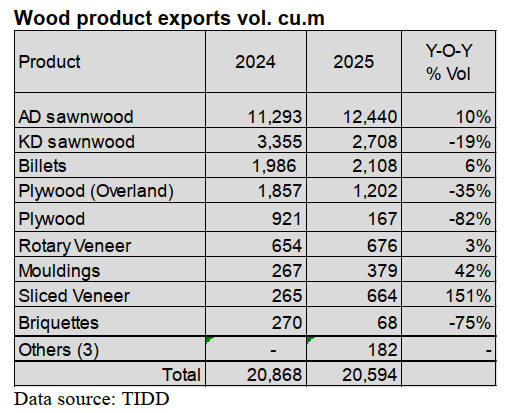
The export performance in January was characterised by
increased exports of sliced veneer (plus 151%), mouldings
(plus 42%) air-dried sawnwood (plus 10%), billets (plus
6%) and rotary veneer plus 3%).
The leading export wood products to the regional market
were air-dried sawnwood (12,440 cu.m), kiln-dried
sawnwood (2,708 cu.m), billets (2,108 cu.m) and plywood
(1,202 cu.m). Together, these accounted for close to 90%
(18,458cu.m) of the total export volume for the period.
Sliced veneer exports generated increased revenue growth
to Eur852,000 in January 2025 from Eur368,000 for the
same period in 2024. Italy accounted for 57% of the export
volume for this product, China 13% and eight other
countries including Denmark, Morrocco, Vietnam and the
USA accounting for the remaining volume.
Air-dried sawnwood exports also increased in January
2025 to 12,440 cu.m (Eur 5.10million) in from 11,293
cu.m (Eur 4.73million) recorded in January 2024
registering 10% and 8% growth in volume and value
respectively.
Teak accounted for 85% of the total export volume of the
wood product. Exports of teak were mainly to the India
(10,57 cu.m) and Vietnam (1,049 cu.m) which together
accounted for 93% of the total volume.
Teak, wawa, ceiba, denya and Cedrela were some of the
other species exported.
Revitalising Ghana’s forestry sector
The Minister for Lands and Natural Resources, Emmanuel
Armah-Kofi Buah, met with a delegation from the World
Bank Ghana led by Country Director, Robert Taliercio
O’Brien. The meeting focused on potential investments
aimed at revitalising Ghana’s forestry sector.
The Minister expressed the government’s readiness to
continue its partnership with the World Bank and
particularly to pursue further investments in the forest
economy.
He highlighted the government’s transformative policies
and structures aimed at improving the forestry sub-sector.
He said, this is an initiative designed to create jobs for the
unemployed youth to embark on the country’s
reafforestation efforts, restore degraded land and protect
the nation’s forest cover.
According to Mr. Buah, these efforts are part of a broader
strategy to enhance sustainable forest management
practices and promote environmental conservation. The
Country Director of the Bank, on his part expressed the
World Bank’s commitment to support Ghana’s forest
economy, on agroforestry issues, restoring depleted forest
covers among others for sustainable growth.
According to a 2024 report by the World Bank,
deforestation and forest degradation cost Ghana an
estimated 2.5% of annual Gross Domestic Product.
See: https://www.gbcghanaonline.com/news/world-bank-
delegation-meets-lands-minister-to-discuss-forestry-
investments/2025/
Fast-track courts to punish illegal miners
As the battle against the illegal miners in the country’s
forest reservescontinues the Minister for Lands and
Natural Resources has hinted at setting up of a dedicated
Fast-Track Courts. Such courts would help swiftly handle
and prosecute persons involved in illegal mining and
environmental degradation. According to the Minister the
current legal process is too slow, which does not deter
offenders.
Speaking to the media, the Minister expressed concern
about the unethical practices of these illegal mining
activities across the country’s forest reserves. He therefore
called for urgent measures to protect Ghana’s forests and
water bodies.
The Minister indicated that, while his ministry is
responsible for policies on land and natural resource
management, enforcement lies with other agencies and he
called for their support. He has therefore initiated
discussions on the idea of the establishment of a Fast
Track Court with the highest levels of government,
including the Attorney General and Chief Justice.
He revealed that data he recently presented to Parliament
showed that 44 of Ghana’s 288 forest reserves have
already been seriously degraded. Nine of the affected
reserves have been classified as “red zones” because of the
level of damage they have suffered.
Meanwhile the Legislative Instrument (L.I.) 2462 seeking
to strip the President of the power to grant licenses for
mining in forest reserves has officially been laid before
Parliament.
If passed, the new legislation would revoke the President’s
authority to grant mining licenses in forest reserves, a
move widely seen as a critical step in tackling illegal
small-scale mining, commonly known as galamsey.
In a related development, the Chief Executive Officer
(CEO) of the Forestry Commission, Dr Hugh Brown, has
also called for the setting up of a special unit in the Ghana
Armed Forces (GAF) for the protection of the country’s
forest reserves against illegal miners.
See: https://www.myjoyonline.com/lands-minister-demands-fast-
track-court-to-punish-illegal-miners/
and
https://www.myjoyonline.com/ghana-has-lost-44-of-forest-
reserves-due-to-illegal-mining-and-logging-activities-lands-
minister/
and
https://www.myjoyonline.com/forest-mining-l-i-2462-to-remove-
presidential-power-in-granting-licenses-laid-in-parliament/
Ghana’s export competitiveness declining
The African Centre for Economic Transformation (ACET)
has said Ghana’s export competitiveness has weakened
over the last two decades and is still declining. In its
Country Economic Transformation Outlook (CETO)
report for Ghana ACET mentioned that the country’s
exports remain concentrated on moderate and low
complexity products, reflecting limited diversification and
export sophistication.
According to the report, weak value addition and minimal
processing have hindered technology upgrading, slowing
industrial progress. About 94% of the country’s current
exports have low technological content which has not
changed significantly over the last 30 years. Consequently,
the need to expand and deepen non-traditional exports and
higher value products is crucial for competitiveness and
economic resilience.
Although there have been some shifts in export markets,
with increased exports to other African countries –
particularly within ECOWAS – Ghana still faces
challenges in expanding beyond its traditional export
destinations, says the report.
Timber and wood products are one of Ghana’s export
commodities shipped to five major market destinations
globally. These are categorised into Primary Products,
Secondary Wood Products and Tertiary Wood Products.
Statistics show that, the country’s wood product exports
are largely primary and secondary, accounting for over
90%.
See: https://thebftonline.com/2025/03/19/editorial-export-
competitiveness-wanes/
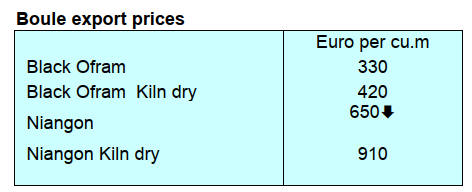 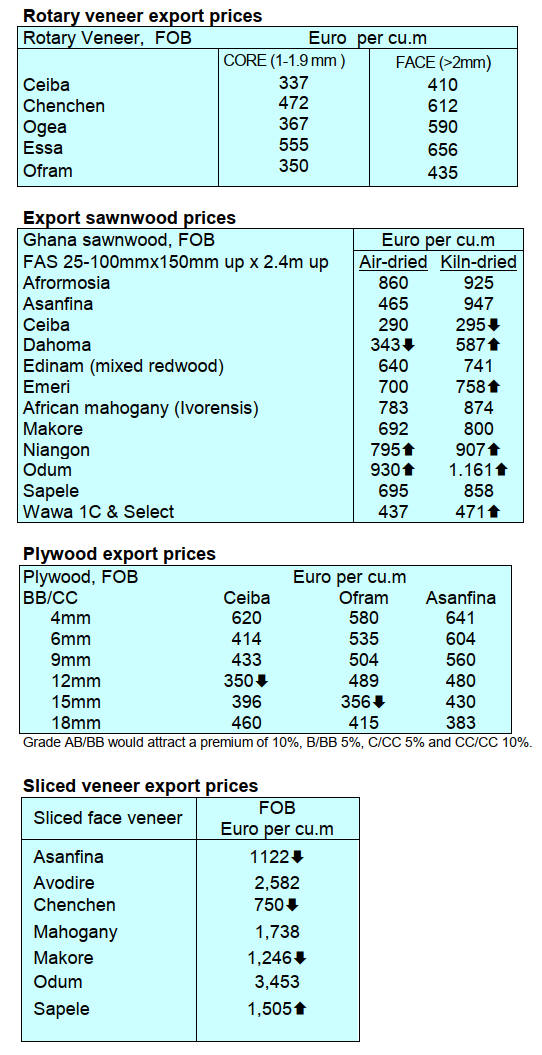
Through the eyes of industry
The latest GTI report lists the challenges identified by the
private sector in the Ghana.
See: https://www.itto-
ggsc.org/static/upload/file/20250318/1742261179154976.pdf
3. MALAYSIA
Growth to be sustained by domestic consumption
The Malaysian central bank (Bank Negara Malaysia
BNM) has forecast Malaysia’s economy to grow between
4.5 and 5.5% in 2025 driven by sustained domestic
demand despite heightened external uncertainties that
could slow export growth.
Inflation is projected to trend higher but remain
manageable amid easing global costs and the absence of
excessive demand pressures.
Malaysia’s economy grew by 5.1% in 2024 with a
moderate inflation of 1.8% while the Ringgit ended 2.7%
higher against the US dollar.
See:
https://www.malaymail.com/news/malaysia/2025/03/24/malaysia
s-economy-to-grow-45-55pc-in-2025-inflation-manageable-says-
bank-negara/170678
Long-Term visit pass for foreign businesses
From 1 April 2025 the Malaysian Immigration Department
will introduce a Long-Term Social Visit Pass for Foreign
Businesses and Investors aiming to streamline the entry
process for foreign investors and facilitate long-term stays.
Also known as the Investor Pass, it aims to facilitate the
entry for those committed to invest in Malaysia.
See: https://www.humanresourcesonline.net/malaysia-s-new-
investor-pass-to-facilitate-long-term-stay-for-foreign-investors-
effective-1-april-2025
CITES listing of Shorea timbers
In an article in the Malaysian Sun newspaper, Wong Kar
Wai the Timber Exporters’ Association of Malaysia
(TEAM) Treasurer, is reported as saying the proposed
classification under the Convention on International Trade
in Endangered Species of Wild Fauna and Flora (CITES)
of extensively traded Malaysian timber species in will
result in disruption of timber exports.
The Sun reports that, in a letter to members, TEAM
president, Chua Song Fong, noted that the European
Commission and the US have proposed the inclusion of
Shorea species (such as Balau, Red Meranti, Yellow
Meranti and White Meranti) and Apitong (keruing) in a
CITES appendix. If approved, he said, the listing would
result in strict trade restrictions on these timber species
significantly impacting the domestic industry.
A vote on inclusion of Shorea is scheduled for the CITES
CoP20 Conference in Uzbekistan to be held in Uzbekistan.
See: https://thesun.my/business-news/malaysia-s-timber-
industry-faces-threats-on-two-fronts-us-tariffs-and-cites-
JK13807097#google_vignette
Carbon credit system for forestry sector
Malaysia is developing a national carbon credit system for
the forestry sector termed the Forest Carbon Offset (FCO)
mechanism to promote transparent carbon trading.
Natural Resources and Environmental Sustainability
Minister, Nik Nazmi Nik Ahmad, said: "The ministry has
introduced the REDD+ financial framework. This
initiative offers financial support to state governments for
activities focused on forest conservation and ecosystem
sustainability, particularly to mitigate climate change”.
A key component of the REDD+ financial framework is
the FCO mechanism. It serves as the primary mechanism
for generating carbon credits in the forestry sector for
domestic and international markets.
The aim is to create a domestic carbon credit system
aligned with international standards, including Verra and
the Gold Standard, while ensuring competitive fees. The
system is being developed with inputs from stakeholders.
The goal is to instill confidence in the MyHIJAU label,
ensuring that certified products are sustainable and not a
form of greenwashing.
MyHIJAU is a government initiative under the Malaysian
Green Technology and Climate Change Corporation.
See:
https://www.nst.com.my/news/nation/2025/02/1179772/m
alaysia-develops-carbon-credit-system-forestry-sector
Compliance-based carbon markets
By implementing Article 6 of the Paris Agreement
Malaysia seeks to become a leader in compliance-based
carbon markets aligning economic growth with emissions
reductions. As ASEAN Chair in 2025, Malaysia aims to
amplify the region’s collective voice on climate action,
emphasising inclusivity and sustainability.
At COP30 in Belem, Brazil (Nov 10 to Nov 21, 2025), we
will present the ASEAN Joint Statement on Climate
Change, advocating for regional solidarity, sustainable
development, and financial support. Malaysia will also
advance the development of the South-East Asia Alliance
negotiation bloc (Group SEA) to strengthen Asean’s
influence in global climate negotiations.
See:
https://www.thestar.com.my/opinion/letters/2025/03/14/committ
ed-to-advancing-climate-action-globally
Blue carbon project
Sarawak’s inaugural Blue Carbon Project in the Paloh and
Serdeng areas of Tanjung Manis will restore and preserve
10,232 hectares of mangrove forest ecosystems.
According to the Sarawak Timber Industry Development
Corporation (STIDC) Sustainable Resource Management
Division Assistant General Manager, Hamzah Morshidi,
the project development design will be submitted to the
Forest Department for issuance of carbon permit, which
will enable the carbon to be marketed in the area within
two years after replanting.
With the help of the consultants, he added, we will
develop more structured development for the coastal area
in the future. STIDC and Worldview Climate Solutions
signed a Memorandum of Agreement to mark the
launching of the project in November last year.
See: https://www.theborneopost.com/2025/03/20/sarawak-
launches-first-blue-carbon-project-in-tanjung-manis-to-restore-
10232-ha-of-mangroves/
Through the eyes of industry
The latest GTI report lists the challenges identified by the
private sector in Malaysia.
See: https://www.itto-
ggsc.org/static/upload/file/20250318/1742261179154976.pdf
4.
INDONESIA
Full repatriation of revenue from natural
resource
exports
The government has mandated that exporters retain 100%
of their export earnings from natural resources in the
Indonesian financial system for a minimum of one year.
This regulation took effect on 1 March. It has been
estimated that approximately US$80 billion will be
repatriated this year.
The regulation applies to various business entities
including companies receiving credit or loans from state-
owned banks, those holding Business Use Permits (HGU),
companies managing industrial forest plantations (HTI)
and all other export-oriented enterprises.
Coordinating Minister of Economic Affairs, Airlangga
Hartarto, stated that the government will provide a range
of incentives to exporters, including those related to the
banking sector, such as arrangements for cash collateral.
"The banking sector will provide cash collateral facilities
and the use of cash collateral will not be included in the
Maximum Credit Limit nor reduce the gearing ratio" said
Airlangga.
See: https://en.tempo.co/read/1989542/todays-top-3-news-10-
best-night-markets-in-bangkok-top-spots-for-shopping-and-
street-food?tracking_page_direct
Opportunities for furniture in Mexico
The Ministry of Trade, through the Indonesian Trade
Promotion Center (ITPC) in Mexico City, hosted a
business pitching meeting for micro, small and medium
enterprises active in the furniture sector. The event was
supported by Bank Syariah Indonesia.
The Head of ITPC Mexico City, Sunny Andrian, said that
Mexico has a rapidly growing tourism industry which
drives growth in construction of hotels, resorts, restaurants
and spas presenting opportunities for the export of
Indonesian furniture products.
Indonesian furniture products face strong competition
from both domestic and international companies. Mexico
is a significant player in the global furniture industry
primarily serving the United States market.
Mexico imposes relatively high tariffs on imported
furniture products. In addition to competition from local
manufacturers, Indonesia would also have to compete with
products from Vietnam and Malaysia. These countries
benefit from exemptions on import duties due to the
Comprehensive and Progressive Agreement for the
Transpacific Partnership (CPTPP) trade agreement making
their products more competitive.
"Since Indonesia and Mexico do not have a trade
agreement it's important to examine which products are
competitive and have unique characteristics," Sunny
stated.
See: https://www.antaranews.com/berita/4728761/itpc-buka-
peluang-produk-furnitur-indonesia-ke-pasar-meksiko
and
https://validnews.id/ekonomi/itpc-mexico-city-sebut-jaringan-
hotel-meksiko-minati-produk-furnitur-ri
Opportunity for RI in Chinese factory relocations
Deputy Minister of Industry, Faisol Riza, has said that
Indonesia has the potential to take advantage of the
momentum of factory relocations from China to ASEAN
countries.
Regarding the news that China's plan to relocate 630 of its
furniture factories to Vietnam, Riza said that Indonesia
could take advantage of this momentum to attract
investors from China to establish factories in Indonesia.
The Chinese factory relocation is said to be due to the
protectionism policy in the United States (US) but said
Raza, Vietnam has a large trade surplus with America and
is likely to face tariffs so he advised Chinese entrepreneurs
to re-evaluate their relocation and consider Indonesia.
Earlier, Riza confirmed that several Chinese entrepreneurs
were interested in relocating their factories to the Kendal
Special Economic Zone (SEZ) in Central Java.
See: https://en.antaranews.com/news/348897/opportunity-for-ri-
in-chinese-factory-relocations-govt
Discussion on trade pact continues
It is reported in the domestic press that Indonesia and the
European Union are still trying to reach a consensus on
import licensing in their free trade agreement talks.
Indonesia and the EU have been negotiating a
comprehensive economic partnership agreement (CEPA)
since July 2016.
See: https://jakartaglobe.id/business/indonesia-eu-still-cant-
agree-on-trade-pacts-import-permit
Environmental organisations advocate revision of the
Forestry Law
Several environmental organisations are optimistic that the
Indonesian House of Representatives' plan to revise Law
No. 41 of 1999 on Forestry will bring about significant
improvements in forestry governance. Muhamad
Burhanudin, coordinator of the Indonesian Conservation
Dialogue Forum (FDKI) stated that Law No. 41 of 1999
has served as the foundation for Indonesian forest
governance for over two decades.
"However, with the advancement of time and the growing
pressure on forest resources, it is essential to update this
regulation to address current challenges," he stated during
a discussion organised by the KEHATI Foundation in
collaboration with FDKI.
He specifically highlighted several issues including
deforestation and land conversion which contribute to
greenhouse gas (GHG) emissions and drive climate
change.
Forest Watch Indonesia (FWI) Campaigner Anggi Putra
Prayoga highlighted the incompatibility in current forestry
conditions and challenges. He discussed the impacts of
climate change, deforestation, forest degradation and the
rise in agrarian conflicts, particularly to Law 41 of 1999.
See: https://www.antaranews.com/berita/4719545/organisasi-
lingkungan-harapkan-revisi-uu-kehutanan-yang-holistik
and
https://www.liputan6.com/regional/read/5966624/yayasan-
kehati-dan-fdki-dorong-revisi-ruu-kehutanan-yang-holistik-dan-
partisipatif
Forest fires contributed to deforestation in 2024
In a press conference, Agus Budi Santosa, Director of
Forest Resources Inventory and Monitoring at the Ministry
of Forestry, reported that in 2024 the forest cover area in
Indonesia was 95.5 million hectares.
However, the country experienced a deforestation loss of
175,400 hectares. Agus stated, "the primary cause of this
deforestation was forest and land fires." He also noted that
illegal logging continues to be a significant factor
contributing to the reduction of forest cover in the country.
According to data from the Ministry of Forestry's SiPongi
monitoring system the extent of forest and land fires in
Indonesia in 2024 was recorded at 376,805 hectares.
See: https://www.antaranews.com/berita/4732709/kemenhut-
kebakaran-hutan-jadi-salah-satu-faktor-deforestasi-pada-2024
Social forestry programme to unlock additional areas
for farmers
The government has identified seven million hectares of
land as potential sites for the social forestry programme
which is expected to support efforts to strengthen food
security.
"We have plans for the social forestry programme, an
initiative designated as a national strategic programme"
Minister of Forestry, Raja Juli Antoni, stated in a press
release. "Farmers already have access to 8.3 million
hectares and four million hectares remain available for
use," Antoni added.
The Minister clarified that the newly announced areas
include the remaining 4 million hectares previously
identified, along with newly assessed land. Antoni further
emphasised the government's commitment to encouraging
local farmers to make optimal use of forested areas to
contribute to Indonesia's food and energy self-sufficiency
goals.
To-date, management access has been granted for
approximately 8.3 million hectares across Indonesia,
benefiting around 11,000 forest farmer groups through
five different schemes: Community Forests (Hkm),
Village Forests, Community Plantation Forests,
Customary Forests and Forestry Partnerships.
The economic impact of the activities carried out by these
forest farmer groups is significant, as reflected in the
Economic Transaction Value (NTE) generated from the
sale of forest product commodities by these groups.
See: https://en.antaranews.com/news/348629/social-forestry-
program-to-unlock-7-million-hectares-for-farmers-govt
and
https://www.agrofarm.co.id/2025/03/nilai-transaksi-ekonomi-
dari-perhutanan-sosial-tahun-2024-capai-rp-15-triliun/
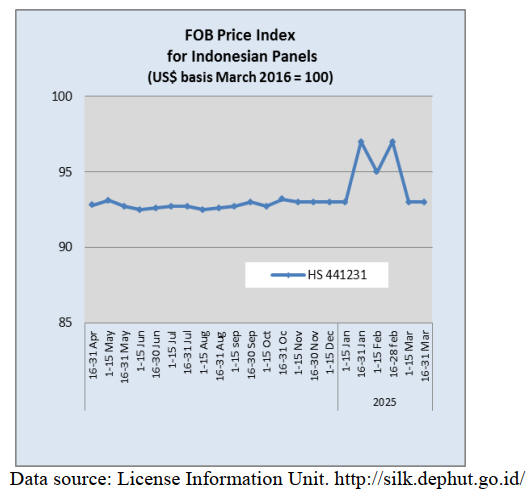
5.
MYANMAR
Election announcement
Speaking at the annual Armed Forces Day parade in
Naypyidaw, Senior General Min Aung Hlaing, pledged to
hold a free and fair election in December and vowed to
transfer power to the winning party, urging armed
opposition groups to renounce violence and pursue
dialogue.
See: https://www.reuters.com/world/asia-pacific/myanmar-junta-
chief-announces-election-december-2025-or-january-2026-2025-
03-08/
2024 in review
Myanmar’s economy faced significant challenges in 2024.
Economic activity was constrained by elevated conflict,
increased macroeconomic volatility and a challenging
business environment. In addition to its ongoing impacts
on household livelihoods and agricultural production,
conflict continued to disrupt land border trade with China
and Thailand, as well as domestic supply chains.
Myanmar’s economy continues to face a range of
constraints including trade and logistics disruptions,
rapidly rising prices and shortages of a range of key inputs
including labour, electricity and imported inputs. Conflict
has led to substantial displacement among affected
populations, disrupted the transport of goods within the
country and disrupted cross-border trade.
The activation of the conscription law has reportedly
prompted significant migration out of major urban areas
toward rural border areas and to Thailand, with some firms
reporting labour shortages as a result.
Continued exchange rate depreciation and constrained
access to import licenses has resulted in higher prices and
ongoing shortages of imported inputs. Electricity outages
have worsened further as gas-powered supply falters, with
firms forced to use expensive diesel-powered generators to
substitute for grid-based power.
The economic outlook remains very weak, implying little
respite for Myanmar’s households over the near to
medium term.
See: https://documents.worldbank.org/en/publication/documents-
reports/documentdetail/099061124195517221/p5006631cca5960
7d182041fae76ab566cc
Impact of food aid cut
The United Nations World Food Programme (WFP) has
warned that more than one million people in Myanmar
will be cut off from WFP’s lifesaving food assistance
starting in April due to critical funding shortfalls. These
cuts come just as increased conflict, displacement and
access restrictions are already sharply driving up food aid
needs.
Without immediate new funding WFP will only be able to
assist 35,000 of the most vulnerable people,
including children under the age of five, pregnant and
breastfeeding women and people living with disabilities.
“The impending cuts will have a devastating impact on the
most vulnerable communities across the country, many of
whom depend entirely on WFP’s support to survive,” said
Michael Dunford, WFP’s Representative and Country
Director in Myanmar.
“WFP remains steadfast in its commitment to support the
people of Myanmar but more immediate funding is crucial
to continue reaching those in need.”
The cuts will also impact almost 100,000 internally
displaced people in central Rakhine who will have no
access to food without WFP assistance, including
Rohingya communities in camps.
WFP urgently needs US$60 million to maintain its life-
saving food assistance to the people of Myanmar this year.
“WFP is calling on all partners to identify additional
funding to meet the needs in Myanmar as the situation
across the country continues to deteriorate,” said Dunford.
See: https://www.wfp.org/news/wfp-warns-one-million-
myanmar-be-cut-food-aid-amid-funding-shortfall
Central Bank intervenes to stabilise currency
According to DVB online news, the Central Bank of
Myanmar (CBM) has stepped up efforts to stabilise the
exchange rate by selling an average of US$2.2 million
daily to select fuel and edible oil importers.
In March alone, the CBM injected over US$57 million
into the market and announced on 17 March an additional
US$33 million will be allocated to fund imports.
Since October 2024, exporters have been required to
convert foreign currency earnings at a fixed rate of MMK
3,600 per dollar, well below market value. This policy has
exacerbated financial strain on factories, making it
difficult to raise wages amid rising inflation.
Labour rights groups say that workers’ real wages
have
declined by at least 43% since 2018, pushing many below
the poverty line.
See- https://burmese.dvb.no/post/695538
6.
INDIA
Tier 2 and 3 cities
shaping India’s real estate future
The Confederation of Real Estate Developers’
Associations of India (CREDAI) recently concluded its
6th “New India Summit” at Nashik, Maharashtra
underscoring the pivotal role of Tier 2 and Tier 3 cities in
India’s real estate evolution. Themed “Viksit Bharat –
Unlocking Potential of Emerging Cities” the summit
brought together key policymakers, industry leaders and
stakeholders to chart a roadmap for inclusive urban
development.
The event marked the launch of a report ‘Overview of
Residential Real Estate Market in 60 Major Cities of
India’, a collaborative study with Liases Foras a leading
real estate research firm.
The report highlights a significant surge in the role of Tier
2 and 3 cities in shaping India’s real estate future revealing
that 44% of the 3,294 acres of land acquired by developers
in 2024 were concentrated in these emerging hubs.
Housing sales in 2024 reached 681,138 units across 60
cities, recording an impressive 23% year-on-year increase.
With the real estate sector now valued at Rupee 22.5
trillion and contributing 7.2% to India’s GDP, Tier 2 and 3
cities are becoming growth engines offering both
affordability and investment returns.
While the main cities continue to dominate luxury and
premium housing sales the rise of Tier 2 and 3 cities has
introduced a more balanced market dynamic where mid-
range and affordable properties play a crucial role in
driving demand.
Many of these cities are evolving into academic, logistics
and industrial hubs further fuelling housing requirements,
says the report.
Manoj Gaur, Chairman of CREDAI, said “Tier 2 and 3
cities are the cornerstone of India’s next phase of
urbanisation, driving inclusive growth and economic
diversification.
As highlighted in the report these cities now account for
nearly half of all land acquisitions by developers,
signalling a seismic shift in investment patterns.
Boman Irani, CREDAI president, said “India’s real estate
sector is undergoing a paradigm shift, with Tier 2 and 3
cities playing a central role in urban expansion. As these
cities become economic and industrial hubs, there is an
increasing demand for affordable and mid-segment
housing. Developers are recognising this shift, leading to a
surge in investments and new projects.
The insights from this report will help the industry
navigate the evolving market and ensure sustainable
growth across regions.”
See: https://www.constructionweekonline.in/events/credai-new-
india-summit
Agroforestry contributes massive volumes to wood-
based industries
The March issue of Plyinsight carries a story on the
contribution of farm forests to wood-based industries.
According to the India State of Forest Report (ISFR)-2023
India’s recorded forest area comprises 52 million hectares
of forest cover (FC) inside recorded forest areas and 30.7
million hectares under trees outside forests (TOF).
According to ISFR-2023 India’s tree cover area under
agroforestry was 1.27 million hectares in 2023. The
potential production of industrial wood from TOF, mainly
from agroforestry, has been estimated as 91.5 million cu.m
per year, an increase of 30% over the estimate of industrial
wood reported in ISFR-2017.
Andhra Pradesh and Telangana lead in commercial
agroforestry due to the promotion of clonal forests of
eucalyptus, casuarinas and subabul to meet the raw
material demand. Plyreporter says the Tamil Nadu
agricultural university played a major role in encouraging
the planting of neem, Melia dubia.
It has been reported that farmers of States of Uttar
Pradesh, Punjab and Haryana are cultivating eucalyptus
and poplar finding this more profitable than traditional
agricultural crops. As a result of agroforestry these states
produced substantial amounts of farm wood, fostering the
growth of the plywood industry.
Between 2013 and 2023 the area under agroforestry in
Uttar Pradesh increased by around 200,000 hectares while
the area is reported to have remained almost unchanged in
Punjab and Haryana states. These states are seeing
agricultural crop yields declining due to changes in the
watertable and have switched to cultivation of tree crops.
The (ISFR)-2023 has the following observations:
Agroforestry has significantly contributed to increasing
forest cover outside RFAs and tree cover in southern
India. Given the large coastal expanses of many of the
southern states this advantage can be further harnessed to
develop wood-based industries in the region.
In Northern States of Haryana, Punjab, Uttarakhand and
Uttar Pradesh commercial agroforestry has also
substantially increased forest cover outside RFAs and tree
cover on farmlands resulting in greater wood production
from farmlands and fostering the growth of wood-based
industries.
India’s forest and tree cover story is one of mixed result-
significant progress in TOF growth through agroforestry
contrasts with challenges in maintaining dense forest cover
within the RFAs. By embracing agroforestry India can
sustainably balance ecological and developmental needs,
says the (ISFR)-2023.
See: https://plyinsight.com/agroforestry-and-its-contribution-to-
indias-wood-based-industries/
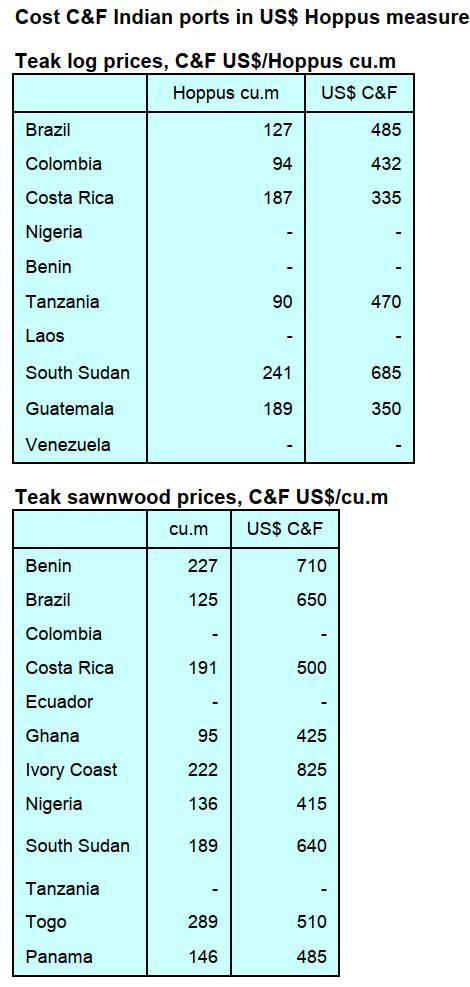
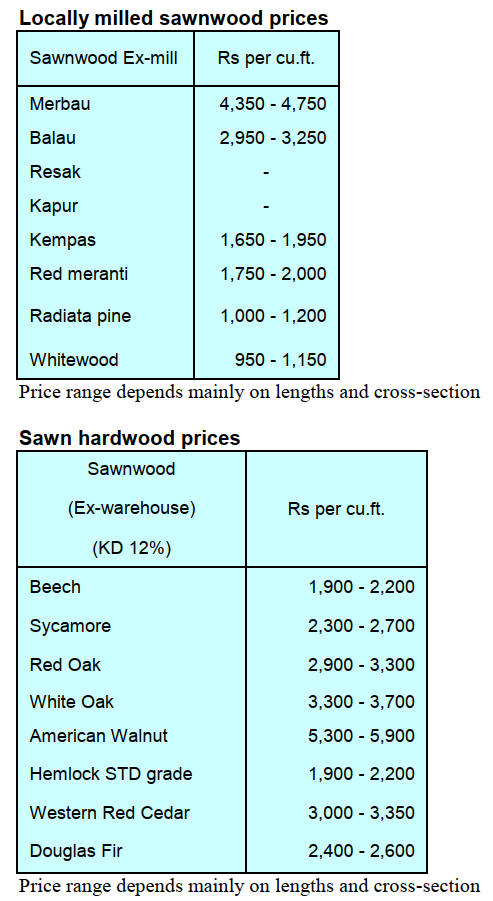
Price revisions proposed by the All Indian Manufacturers
Association have not been introduced because of the slow
market situation. Traders anticipate the new prices will be
effective in April.
Plywood
The recently announced price increases have not been
introduced as domestic demand is weak
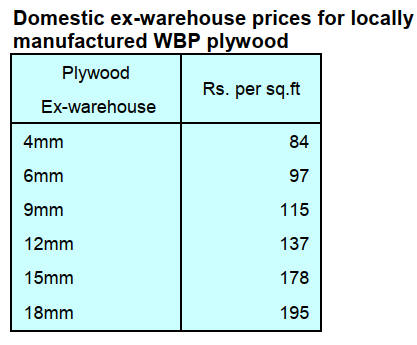
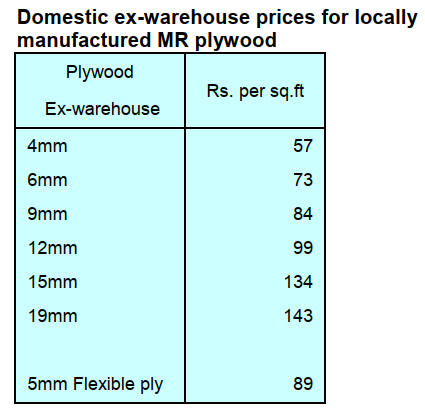
7.
VIETNAM
Wood and Wood product (W&WP) trade
highlights
According to the statistics from Vietnam Office of
Customs W&WP exports to Japan in February 2025
reached US$158.2 million, up 50% compared to February
2024. In the first 2 months of 2025 W&WP exports to
Japan market amounted to US$323.4 million, up 21% over
the same period in 2024.
Vietnam’s W&WP exports to Canada in February 2025
were valued US$16.5 million, up 63% compared to
February 2024. In the first 2 months of 2025 W&WP
exports to Canada fetched US$43.7 million, up 22% over
the same period in 2024.
Vietnam's tali imports in February 2025 were 25,600
cu.m, worth US$9.0 million, up 5% in volume and 6% in
value compared to January 2025.
Compared to February 2024 imports increased by 173%
in
volume and 135% in value. In the first 2 months of 2025
tali imports totalled at 48,800 cu.m, worth US$17.1
million, up 14% in volume and 4% in value over the same
period in 2024.
Cameroon, the largest supplier of tali to Vietnam
In January 2025 Cameroon was the main supplier of tali to
Vietnam accounting for 83% of total imports which were
20,300 cu.m worth US$7.3 million, down 24% in volume
and down 27% in value compared to January 2024.
Vietnam’s imports of logs and sawnwood from ASEAN in
February 2025 amounted to 54,000 cu.m with a value of
US$16.0 million, down 0.3% in volume and down 0.8% in
value compared to January 2025 but an increase of 30% in
volume and 29% in value compared to February 2024.
In the first 2 months of 2025 imports of logs and
sawnwood from ASEAN reached 108,180 cu.m at a value
of US$32.13 million, down 18% in volume and down
15% in value over the same period in 2024.
Exports of wood and wood products to Japan
Due to the impact of the Lunar New Year holidays at the
end of January 2025 W&WP exports to Japan tended to
decrease.
However, exports of wood pellets, a top wood commodity
for Japan, increased in January 2025 and contributed to
maintaining the value of W&WP exports to Japan.
W&WP exports to Japan specifically in January
2025
were headed by wood pellets US$56.9 million, up 55%
compared to January 2024 and accounted for 34% of the
total W&WP exports to Japan. Next was wood chips
reaching US$53.3 million, down 12% compared to
January 2024; wooden furniture valued US$34.9 million,
down 20%; wood pallet and flooring contributed US$15.1
million, down 14%; handicraft furniture reached
US$245,000, a sharp year on year rise.
Wood pellets and wood chips are the 2 main
commodities
exported to Japan. According to statistics from the Japan
Customs Agency, in January 2025 Japan's imports of HS
code 4401 reached 1.6 million tonnes, worth 46.9 billion
yen (equivalent to US$316.9 million), up 13% in volume
and 14% in value compared to January 2024.
Of this, imports from Vietnam amounted to 870,900
tonnes, worth 24.6 billion yen (equivalent to US$165.9
million), up 66% in volume and 83% in value compared to
January 2024 and accounted for 54% of Japan's total
imports of wood chips and wood pellets.
Wooden furniture is also one of the items that Japan
has a
high demand. Japan is the 5th largest W&WP importer
and exports of furniture contributed to Vietnam’s W&WP
exports in 2025.
Vietnamese W&WP exporters who want to ship wooden
products to the Japanese market need to carefully study
Japanese tastes, invest in quality and strictly control the
production process to meet the strict standards of this
market. In addition, it is necessary to focus on quality,
appropriate design, meet technical standards and take
advantage of incentives from the CPTPP to improve
competitiveness.
Tali suppliers and tali price fluctuations
The average import price of tali in the first month of 2025
was US$349/cu.m, down 7% compared to January
2024.The price of tali imports from Cameroon decreased
by 4% compared to January 2024 to US$357/cu.m.
Tali imports from Nigeria contributed 1,600 cu.m total
imports and were valued at worth US$352,000d, up 78%
in volume and 21% in value compared to January 2024.
Tali imports from the Congo were ranked 3rd at 1,300
cu.m, worth US$514,000, down 44% in volume and 45%
in value compared to January 2024.
ASEAN furniture at VIFA ASEAN 2025
The 3rd Vietnam ASEAN International Furniture and
Home Accessories Fair, VIFA ASEAN 2025, will connect
Southeast Asia’s furniture industry to global buyers in Ho
Chi Minh City this August.
Building on the success of previous VIFA EXPO events
the 3rd Vietnam ASEAN International Furniture and
Home Accessories Fair (VIFA ASEAN 2025) is set to
take place from August 26 to 29, 2025 at the Saigon
Exhibition and Convention Center (SECC) in District 7,
Ho Chi Minh City.
This event is poised to become a significant bridge
connecting Southeast Asia's thriving furniture industry
with the global market.
Exhibitors at VIFA ASEAN 2025 will showcase a wide
range of products across four main categories: indoor
furniture, outdoor furniture, home décor - office wares -
handicrafts and machinery, hardware and tools. This
diversity offers a comprehensive platform for both
domestic and international stakeholders in the furniture
industry.
For more information, contact Lien Minh Company, the
event organiser, at 84 79 999 7657 or visit the website at
www.vifafair.com or www.vifaasean.com.
See:https://vietnamnet.vn/en/discover-the-best-of-asean-
furniture-at-vifa-asean-2025-2364134.html
Wood exporters wary on surging tariff pressures
Vietnamese wood businesses are closely monitoring
market developments to swiftly craft solutions in response
to volatile tariff policies on a global scale.
In a talk with VIR, Ngo Sy Hoai, Vice Chairman of the
Vietnam Timber and Forest Products Association
(Viforest), revealed that under normal conditions the goal
would be achievable. However, in the current context of
global trade turbulence it is hard to determine whether the
target will be realised.
The US President recently ordered an investigation under
Section 232 of the 1962 Trade Expansion Act regarding
wood and wood products. This could result in tariffs of up
to 25% on sawnwood and forest products from April.
The US accounts for over half of Vietnam’s wood exports,
primarily furniture, interior and exterior wood products,
carpentry and refined products with some plywood,
laminated boards.
Hoai noted, “In light of potential changes in policies
Vietnamese wood businesses are worried about the impact
on Vietnam’s wood product export performance.”
Viforest and businesses in the sector have been preparing
to participate in hearings if the US requests proof that the
trade relationship between Vietnam and the US in the
wood sector is mutually beneficial.
In this respect, Hoai argued, “We do not compete or
disrupt US production. Vietnam not only exports to the US
but is also the second-largest market in the world, after
China, for the consumption of US’ logs and sawn timber.
The imported wood volume is used to meet domestic
demand and it is also processed and exported to various
markets.
Many products using US wood are also exported back to
the US as such the trade is mutually beneficial, he said.
Sharing the difficulties of the wood industry, Do Ngoc
Hung, trade counsellor and head of the Vietnam Trade
Office in the US, noted, “The biggest challenge right now
is that Vietnam is not yet considered a fully market-
oriented economy which leads to disadvantages in US
anti-dumping and countervailing investigations.
Meanwhile, the US is also concerned about the trend of
shifting production and investment from some countries to
Vietnam to take advantage of labour cost benefits and the
competitive environment.”
Hung therefore suggested relevant ministries, industries
and business associations consider importing raw wood
materials from the US to reduce the trade deficit and to
avoid origin-related lawsuits. On the side of firms, caution
needs to be exercised regarding raw material imports from
countries that are subject to US tariffs. At the same time, it
is important to develop flexible production and business
plans, as countries subject to US tariffs may strengthen
trade protection measures, placing greater pressure on
Vietnam.
See: https://vir.com.vn/wood-exporters-wary-about-surging-
tariff-pressures-124396.html
Strategies to address tariff increases
Ngô Sỹ Hoài, Vice Chairman and General Secretary of the
Vietnam Timber and Forest Products Association
(Viforest), emphasised the importance of increasing log
and sawnwood imports from the U.S. “This ensures a legal
and transparent supply chain, strengthens compliance with
origin standards and facilitates exports to key markets like
the U.S. and Japan,” Hoài noted.
According to Võ Quang Hà, Chairman of Tavico,
Vietnam’s furniture market is valued at US$5 billion
annually yet remains underdeveloped. He suggests that
businesses should shift focus to the domestic market for
example supplying furniture for real estate developments
and expand traditional retail networks and e-commerce
channels. He added in the public sector manufacturers
could capitaliseg on government-funded projects. By
leveraging these opportunities, Vietnam’s furniture
industry can reduce dependency on exports and build a
more resilient domestic market.
Opportunities and prospects for Vietnam’s wood
industry
Despite the challenges Vietnam’s wooden furniture sector
remains optimistic about growth opportunities.
Ngô Sỹ Hoài, Vice Chairman of Voforest,
emphasised: “The U.S. cannot easily replace Vietnam as a
key supplier. Over the past 20 years we have built a strong
reputation for quality, design and compliance with
regulations. “The U.S. tariff policy may pose challenges to
Vietnam’s wooden furniture exports but businesses can
proactively adapt.
By adjusting tax policies, leveraging opportunities
to import legal wood and expanding the domestic market
the industry could maintain sustainable growth.
See: https://ssr-logistics.com/en/vietnams-wooden-furniture-
exports-us-tariff-challenges/
8. BRAZIL
Study suggests new approach to Amazon
forest
preservervation
A study conducted by ESALQ (Luiz de Queiroz College
of Agriculture) proposes new strategies to preserve the
genetic diversity of the Amazon rainforest. The research
suggests species-specific strategies are more effective than
the generalised approaches.
The study assessed the impact of logging based on the
Minimum Cutting Diameter (MCD) which defines the
lower size limit of trees that can be harvested. Researchers
also evaluated whether the trees remaining in the forest
after logging are close enough to ensure pollen exchange
and genetic diversity. The study proposed a new criterion
called Minimum Cutting Distance which considers the
proximity between the remaining trees.
The study was conducted in four forest management areas
in the Amazon totalling 48,876 hectares and suggests that
species and site-specific criteria are more effective than
general rules that use the same standard for all trees. The
results indicate that adopting ‘customised’ approaches can
contribute to sustainable forest management, ensuring
biodiversity conservation and the continuation of the
Amazon's ecosystem services.
The researchers advocate revising current logging
regulations to incorporate policies that balance production
and environmental conservation. The study highlighted
that maintaining adequate distances between trees
promotes cross-pollination thus increasing genetic
variability.
This genetic diversity is essential for the resilience of tree
populations against environmental changes. The proposed
Minimum Cutting Distance criterion is considered more
effective than the Minimum Cutting Diameter (MCD) as
established in Brazilian legislation, say the researchers.
See: https://www.remade.com.br/noticias/20578/estudo-da-esalq-
pode-mudar-forma-de-preservar-florestas-no-brasil
New Sustainable Forest Management Law in Roraima
State
The Legislative Assembly of Roraima (ALE-RR) has
approved Law nº 2.122/2025 which updates the
Sustainable Forest Management Plan (SFMP) to promote a
better balance between agricultural production and
environmental preservation. The new regulation provides
more flexibility to producers without compromising
ecological guidelines.
It allows for the modification of the Term of
Responsibility for Forest Management Maintenance in
specific cases of Legal Reserve reduction as outlined in
the Ecological-Economic Zoning of Roraima (ZEE-RR).
As a result, properties located in Productive Use Zones
can adjust their preserved areas to up to 50% of the total
area provided they comply with established environmental
criteria.
The new legislation establishes 2 May 2018 as the
reference date for forest inventories. Projects initiated
before this date require a new environmental assessment
while those initiated afterward will have their remaining
timber volume calculated through the Brazilian National
System for the Control of Origin of Forest Product
(SINAFLOR). The entire sustainable management process
will continue to be monitored by the State Foundation for
Environment and Water Resources (FEMARH).
Sustainable forest management has become an essential
tool for profitable and ecologically responsible agricultural
production, enabling the sustainable use of land by
integrating areas for use with the preservation of
biodiversity.
In the case of Legal Reserves which must maintain
between 20% and 80% of native vegetation the legislation
prohibits activities such as extensive cattle ranching and
monoculture planting. However, it allows the sustainable
subsistence farming of crops as long as at least 50% of the
area remains untouched.
Agroforestry systems, including the cultivation of Brazil
nuts, cupuaçu, guaraná and andiroba have already shown
positive results, promoting a balance between agricultural
production and the preservation of fauna. Alternative
crops like cashew and açaí are also being tested to
diversify the local economy.
With reduced bureaucracy and incentives for good
practices the new legislation strengthens Roraima's
commitment to sustainable development positioning the
state as a national reference in sustainable forest
management.
See: https://forestnews.com.br/roraima-avanca-no-manejo-
florestal-com-nova-lei-da-assembleia-legislativa/
Export update
In February 2025 Brazilian exports of wood products
(except pulp and paper) decreased 8.5% in value compared
to February 2024, from US$304.5 million to US$278.6
million.
Pine sawnwood exports increased 21% in value between
February 2024 (US$55.6 million) and February 2025
(US$67.5 million). In volume, exports increased 15% over
the same period, from 248,500 cu.m to 285,100 cu.m.
Tropical sawnwood exports decreased 0.5% in volume,
from 21,000 cu.m in February 2024 to 20,900 cu.m in
February 2025. In value, exports decreased 18% from
US$10.4 million to US$8.5 million over the same period.
Pine plywood exports increased 0.2% in value in February
2025 compared to February 2024, from US$57.5 million
to US$57.6 million. In volume, exports increased just over
3% over the same period, from 180,300 cu.m to 186,400
cu.m.
As for tropical plywood, exports increased in volume by
28% and in value by 30%, from 1,000 cu.m and US$1.8
million in February 2024 to 1,300 cu.m and US$2.3
million in February 2025.
The value of wooden furniture exports increased from
US$45.8 million in February 2024 to US$46.3 million in
February 2025, an increase of 1%.
Brazil advances creation of Tropical Forests Forever
Fund
Representatives from Brazil and other countries gathered
in London in early March to advance the development the
Tropical Forests Forever Fund (TFFF) whose objective is
to secure sustainable financing for the preservation of
tropical forests.
The fund intends to combine financial returns for investors
with the allocation of a portion of the profits to countries
that protect their forests. The financing model proposes
that 20% of the resources will be subsidised by the
governments of participating countries while the
remaining 80% will be raised from financial markets.
The TFFF aims to raise US$125 billion from international
sources at market interest rates, positioning itself as a low-
risk asset. This money will be invested in projects with
higher rates of return thus generating profits. Part of this
profit will be returned to investors while the balance will
go to countries that preserve their tropical forests in
proportion to the area conserved.
This model ensures that investors recover their resources
with a return aligned with regular market rates while also
contributing to environmental preservation and the
reduction of carbon emissions.
In addition to supporting conservation efforts the TFFF is
expected to stimulate demand for sustainable debt
instruments such as green and blue bonds. The fund will
not compete with the carbon credit market but act as a
complementary mechanism.
The TFFF has gained momentum, especially following a
technical partnership with the World Bank and the Interim
Advisory Committee countries, which include Germany,
Colombia, the United Arab Emirates, France, Norway, and
the United Kingdom. These countries have committed to
supporting the development of the financial mechanism to
provide financial compensation for tropical rainforests
conservation.
For both investor countries and private investors, the
model presents a more advantageous alternative to
traditional environmental donations, as invested resources
will be repaid within 30 to 40 years, with interest.
See: https://agenciagov.ebc.com.br/noticias/202503/em-londres-
brasil-avanca-na-construcao-do-fundo-florestas-tropicais-para-
sempre
Support for forest recovery project
The Brazilian Development Bank (BNDES) has expressed
its interest to the government of Pará State in evaluating
the Triunfo do Xingu Recovery Unit (URTX) project
located in the southern region of Pará State in the Amazon
Region which aims to restore more than 10,000 hectares
with native tree species.
The support may include financing for the institution
awarded a forest concession under the bidding process
(subject to technical and legal analysis). The project is
aligned with Brazil's environmental goals to restore 12
million hectares of native species by 2030.
As part of the State Native Vegetation Restoration Plan
(PRVN) the project involves grants for ecological
restoration with authorisation to generate and trade forest
carbon credits, credits for environmental services, timber
and non-timber products and forest services within the
URTX. The URTX is expected to restore 10,300 hectares
of native vegetation over the 40-year concession period.
See: https://forestnews.com.br/bndes-manifesta-interesse-em-
apoiar-projeto-de-recuperacao-florestal-no-sul-do-para/
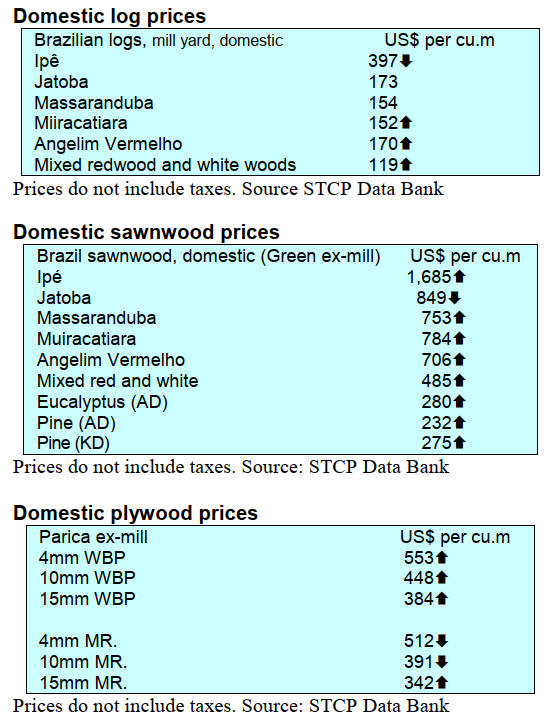

Export prices
Average FOB prices Belém/PA, Paranaguá/PR,
Navegantes/SC and Itajaí/SC Ports.
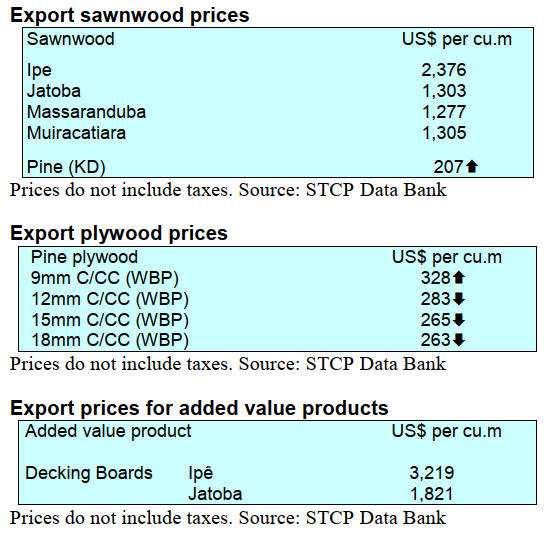
Through the eyes of industry
The latest GTI report lists the challenges identified by the
private sector in Brazil.
See: https://www.itto-
ggsc.org/static/upload/file/20250318/1742261179154976.pdf
9. PERU
Timber sector faces
structural challenges – exports
decline
Shipments of wood products reached US$1.6 million in
January 2025 representing a decrease of 43% compared to
January in 2024 (US$2.8 million) according to the Center
for Global Economics and Business Research of the
Exporters Association.
According to the president of the ADEX Wood and Wood
Industries Committee, Erik Fischer Llanos, the sustained
decline in the timber sector highlights the structural
challenges it faces. The Peruvian Amazon forest occupies
over 60% of the national territory yet the timber sector
contributes less than 1% to GDP. According to figures
from the ADEX Data Trade Trade Intelligence System
export items included other wood products (US$540,000)
and decking (US$426,000).
The leading destination for wood product exports was the
Dominican Republic with shipments abroad totalling
US$384,000. This was followed by Mexico
(US$383,000), China (US$234,000), France
(US$126,000) and the United States (US$112,000).
The top ten markets were completed by South Korea,
Belgium, South Africa, Slovenia and Denmark.
One million hectares of certified forests
According to the Forest Stewardship Council (FSC) Peru
has 1.1 million sustainably managed forests in Madre de
Dios, Loreto and Ucayali under FSC standards.
Certification of productive forests under these standards
ensures that their management maintains biological
diversity, protects the livelihoods of communities and the
rights of local workers and stimulates the local and
regional economy.
Nine Peruvian Departments for forest zoning
The National Forest and Wildlife Service (SERFOR) has
prioritised nine Peruvian Departments for the
implementation of the forest zoning process, a key tool for
sustainable forest management.
The following departments have been identified for this
phase: Cusco, Puno, Amazonas, Apurímac, Ayacucho,
Tumbes, Moquegua, Arequipa, and Tacna. This
prioritisation is based on the use of criteria related to the
presence of forests and the pressure on forest ecosystems.
This process promotes the development of the forestry and
wildlife sector, contributes to granting legal status to
productive activities so making goods and services more
competitive in national and international markets.
See: https://www.gob.pe/institucion/serfor/noticias/1134376-
serfor-prioriza-nueve-departamentos-del-peru-para-la-
zonificacion-forestal-en-este-2025
Junín Region propose plantation incentives
A SERFOR team evaluated the proposed Law on
Incentives for Commercial Forest Plantations, presented
by the Junín Forestry Technical Board.
This initiative aims to promote forest development in
collaboration with the State and private sector with a focus
on competitiveness for the benefit of rural communities.
SERFOR will provide legal and technical assistance to
promote this proposed law.
SERFOR achieves ISO 9001 certification
The National Forest and Wildlife Service (SERFOR) has
obtained international ISO 9001:2015 certification. This
recognition strengthens transparency and trust in the
issuance of export permits for specimens, products, and
byproducts of wild flora and fauna for commercial
purposes, including those regulated by the Convention on
International Trade in Endangered Species of Wild Fauna
and Flora (CITES).
This international certification guarantees a reliable and
efficient service as processes are aligned with international
standards ensuring greater transparency.
See: https://www.gob.pe/institucion/serfor/noticias/1129815-
serfor-logra-certificacion-internacional-iso-9001
Technology transfer for monitoring forest resources
The Forest and Wildlife Resources Oversight Agency
(OSINFOR) will begin a process of technology transfer
for monitoring and inspection for forest resources in
Madre de Dios. The methodologies include the use of
satellite images and an algorithm for detecting logging.
OSINFOR will also be responsible for forming a multi-
sectoral technical team to identify opportunities for
improvement in the implementation of the Enabling Title
process.
This working group will include representatives from the
National Forest and Wildlife Service (SERFOR) and the
Regional Forestry and Wildlife Management Bureau
(GRFFS).
See: https://www.gob.pe/institucion/osinfor/noticias/1134472-
osinfor-transferira-al-gobierno-regional-de-madre-de-dios-
tecnologia-para-supervision-y-fiscalizacion-de-los-recursos-
forestales
AI monitoring in Peruvian forests
OSINFOR is moving forward with the development of
version 2 of the selective logging detection algorithm
(ADETOP). This innovative update will be developed in
collaboration with the University of Sheffield under the
agreement signed between the two entities.
Using artificial intelligence the development and
implementation of a plugin is planned for the detection of
timber forest species, specifically those of the genera
Handroanthus and Dipteryx, which have been listed under
the Convention on International Trade in Endangered
Species of Wild Fauna and Flora (CITES).
This plugin will analyse the information collected by the
VTOL drones OSINFOR is acquiring which will expand
the area monitored per flight to 300 hectares, fifteen times
the current amount.
According to the work plan the implementation of new
technologies will be designed by July of this year to
continue improving OSINFOR's work.
See: https://www.gob.pe/institucion/osinfor/noticias/1132788-
osinfor-implementa-inteligencia-artificial-para-optimizar-
supervisiones-en-bosques-peruanos
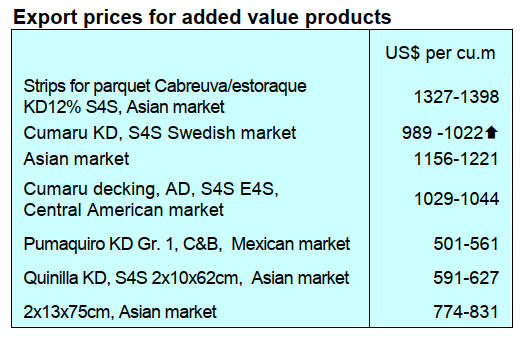

|